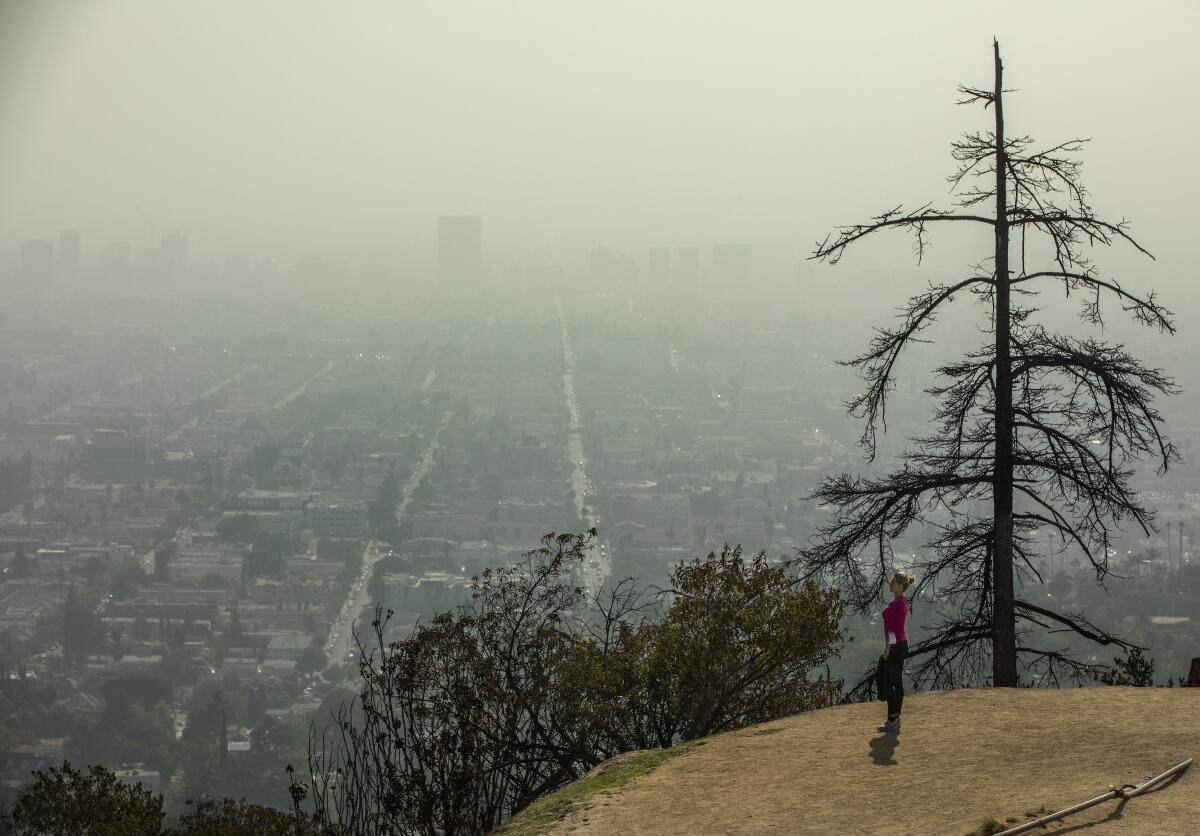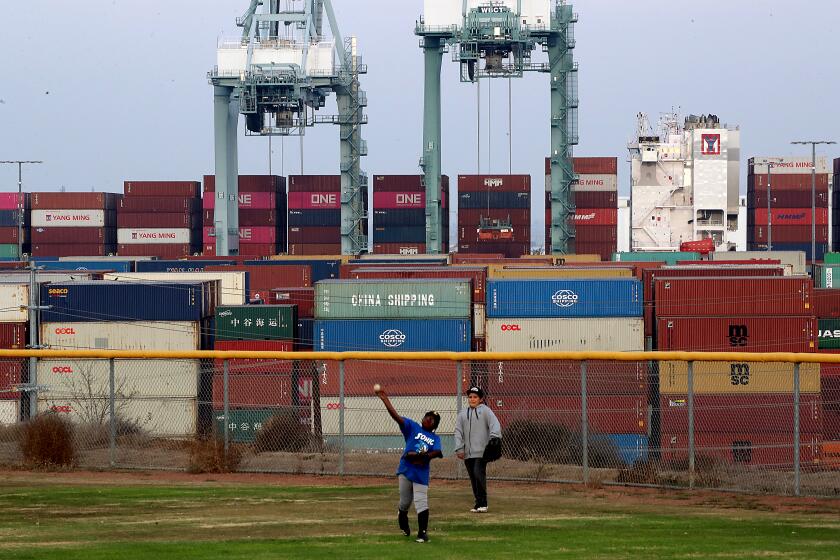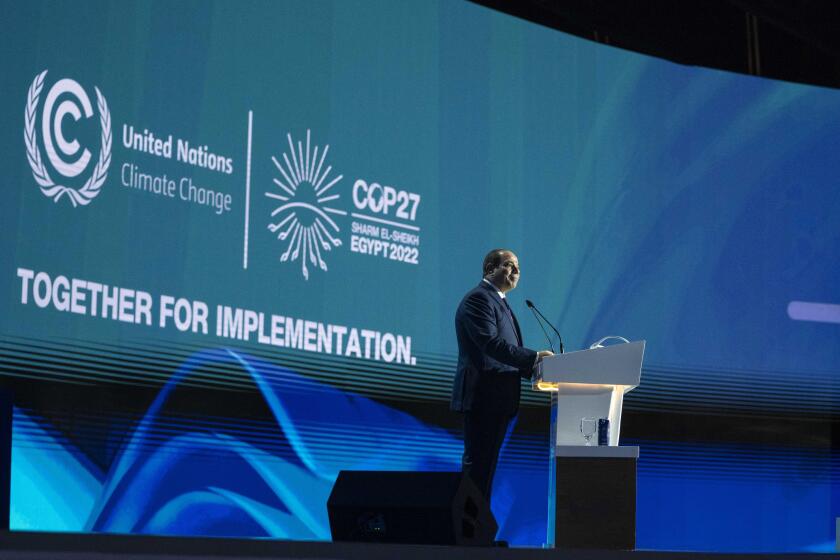Editorial: Southern California smog reduction plan should race to zero emissions

Southern California smog regulators are finally getting on board with what pollution-plagued communities have been telling them for years: To clean the nation’s worst-polluted air, they have to get emissions down to zero.
After decades of focusing on incrementally cleaner combustion, the South Coast Air Quality Management District is poised to adopt a plan that for the first time strives for a zero-emission economy. The district’s governing board is set to vote Friday on its road map for cleaning up ozone pollution, the lung-searing gas in smog, to meet federal health standards by 2037.
Over the next 15 years, the plan, in combination with climate actions underway by the state and federal government, would fuel a transformation of homes, communities and workplaces across a region of 17 million people. Where possible, fossil-fueled vehicles and appliances would be replaced with zero-emission models, including electric cars and trucks, induction stoves and heat pumps that cool and heat buildings. These technologies will begin to eliminate, rather than just reduce, smog-causing and climate-warming pollution.
The air quality board should resist pressure from polluting industries to weaken the plan. The 13-member panel, made up of elected and appointed officials from Los Angeles, Orange, Riverside and San Bernardino counties, has a disappointing record of delaying, watering down or even killing rules to protect public health and safety in the face of pressure from powerful interests, including oil companies and the goods movement industry.
Air pollution at the ports of L.A. and Long Beach surged dramatically during the pandemic. To fix this, city and port officials need to act fast.
But it should now be clear that addressing the climate crisis and air pollution depends largely on the same solution: ending the burning of fossil fuels. Regulators need to use this, and every, opportunity to push faster and further.
Despite dramatic improvements in air quality compared with decades ago, progress in reducing Southern California smog has stagnated and the effort has even backslid in recent years. Regulators have a miserable record of failing to meet air quality standards on time, and the South Coast basin will blow past a key 2023 federal smog-reduction deadline. This year, the region logged 124 bad air days for ozone, with readings as high as 122 parts per billion. The federal health standard is 70 ppb.
The new smog-reduction plan would prevent more than 1,500 early deaths annually and many more asthma attacks, hospital visits and lost work and school days, with higher benefits in the communities hardest hit by pollution, according to the air district.
The plan includes a big focus on electrification of residential appliances, which are still overwhelmingly fueled by natural gas and on track to become one of the region’s top sources of smog-forming pollution.
A new agreement to compensate poor nations for the effects of global warming is an important step for climate justice. But it will be hollow victory until world leaders take decisive action to end fossil fuels.
Business interests have tried to dilute the plan, saying it should remain silent on electrification and should instead be “technology and fuel neutral.” And they complain that business owners and residents will have to shoulder the costs of the transition — when in reality people have long been subsidizing industry pollution with their health.
It’s important to note that although the air quality district‘s plan aims to deploy pollution-free technologies across all sectors, it also adds big asterisks of “where feasible.” The agency’s projections show that under the plan, about half of the water, space heating and cooking at residential and commercial sites will be zero-emission by 2037. Regulators acknowledge there are some big pollution sources for which there are currently no plans to switch to zero-emission technologies, such as airplanes and ships, which are regulated primarily by the federal government.
But it’s still a significant change in tone from the agency’s last big smog-reduction blueprint, which prioritized natural gas, a fossil fuel, as a “near-zero” solution. The 2017 plan focused heavily on raising billions in incentive money for voluntary, pollution-reduction projects that largely failed to materialize. The agency had greater success when it returned to the time-tested approach of requiring industries to clean up. Local regulators have in recent years adopted regulations to cut emissions from powerful industries, including oil refineries and warehouse distribution centers, and are working on rules targeting the heavily polluting ports of L.A. and Long Beach.
There are also stronger tailwinds today thanks to hundreds of billions of dollars in new federal climate funding under the Inflation Reduction Act, which will support projects to accelerate the shift to electric vehicles and appliances powered by renewable energy. State lawmakers have also invested billions in emissions-cutting programs.
Passing the most aggressive air-quality plan possible will put Southern California in a stronger position to get more funds for these projects. But implementation is just as important. Regulators will have to hold firm on their commitment to zero emissions and work quickly to start to deliver the long-overdue air quality improvements people across the region have been promised.
More to Read
A cure for the common opinion
Get thought-provoking perspectives with our weekly newsletter.
You may occasionally receive promotional content from the Los Angeles Times.








